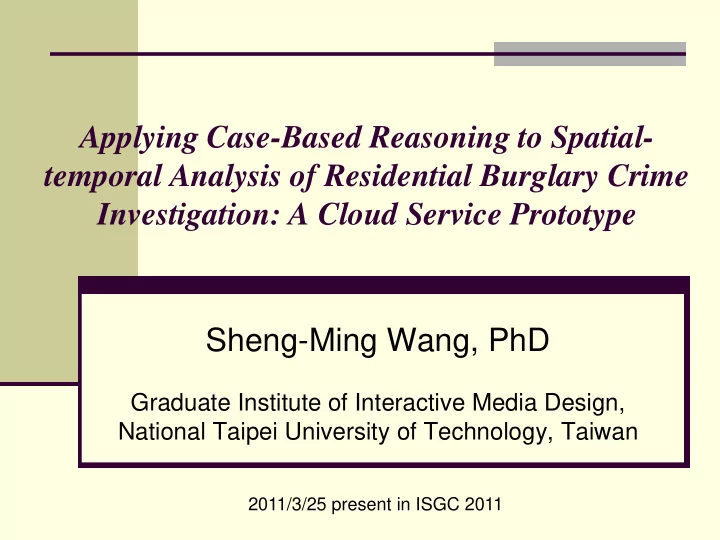

Applying Case-Based Reasoning to Spatial- temporal Analysis of Residential Burglary Crime Investigation: A Cloud Service Prototype Sheng-Ming Wang, PhD Graduate Institute of Interactive Media Design, National Taipei University of Technology, Taiwan 2011/3/25 present in ISGC 2011
Outline Abstract The Spatial and Temporal Evidences of Burglary Crime Scene Investigation (CSI) Solving Problems using Case Based Reasoning The Computation/Services Needs The Conceptual Diagram of Cloud Service Prototype for Burglary CSI Case Studies Results and Discussions Conclusions and Future Studies
Abstract A lot of researches have been done by applying the features of modus operandi, the influence factors of victims, crime prevention measures, and geographic profile of consecutive crime for the investigation of the residential burglary crime. The main objective of this research is to develop a decision support system by applying case-based reasoning (CBR) method for residential burglary investigation using the spatial and temporal evidences of crime case. A cloud service prototype is proposed for developing future collaboration mechanism between organizations.
The Spatial and Temporal Evidences of Burglary Crime and CSI Spatial Distribution of Burglary Cases Temporal Distribution of Burglary Cases Habitual Thieves: Re-appear in certain Places, Periods, Time, and Pattern Modus Operandi: Skill, Preference, Habits Criminal Profiling: Evidences from Personality, Features, Field Response
The Limitations of Rules in CSI The success of rule-based expert systems is due to several factors: They can mimic some human problem-solving strategies Rules are a part of everyday life, so people can relate to them However, a significant limitation is the knowledge elicitation bottleneck Experts may be unable to articulate their expertise Heuristic knowledge is particularly difficult Experts may be too busy…
Another Way of CSI from Past Experiences By referring how we solved similar burglary cases in the past. This is Case Based Reasoning (CBR) memory-based problem-solving re-using past experiences Experts often find it easier to relate stories about past cases than to formulate rules The main assumption is that: Similar burglary cases have similar patterns and evidences
R 4 Cycle Retrieve the cases from the case-base whose problem is most similar to the new case. Reuse the solutions from the retrieved cases to find the suspects for the new case. Revise the proposed suspect to take account of the evidences between the new case and the evidences in the retrieved cases. Retain the new case and its revised suspect as a new case for the case-base if appropriate.
The CBR Cycle and Computation/Service Needs Review Suspects Retain Adapt Retrieve Similar New Cloud Service Cases Cloud Platform (Queue) (Web Front-End) Cloud Cloud Storage Infrastructure (Database) (Billing, VMs)
Concepts of Case Base Reasoning and Cloud Service Instance of Instance of CBR service is provided Instance of CBR Instance of CBR Instance of SERVICE CBR via Cloud service SERVICE CBR CBR SERVICE CBR Knowledge SERVICE interface to a commercial Service SERVICE Model Factory CBR package Case Indexer A S ervice Factory supports CBR Process Managers the creation of multiple CBR instances Permits many CBR processes to be Fault and CBR Indexed executed in parallel Maintenance Indexed casebase Broker Indexed casebase Data from a single service casebase access point
The Conceptual Diagram for Cloud Service Prototype
Similarity Value Measurement n ∑ I R × f f w sim , i i ji I R = = f f i 1 Similarity , n ∑ j w i = i 1 I R : Similarity Value with the j th case in case base f f Similarity , j I : New Case f j : data of the j th case in the case base R f I f : number of feature indicator : the i th feature value of new case n i : total number of features i R f : the i th feature value the j th ji w i case in the case base : the weight of i the feature I R f f sim , : the similarity value of the new case and the i th feature of the j th case i ji in the case base
Case Studies Results and Discussions The 128 collected burglary cases in DB The spatial distribution of collected Burglary Cases 128 burglary crime case between 2007-2009 have been collected from the jurisdiction of 2 local police stations. 3 Categories(Spatial and Temporal, Convict Approaches, Field Characteristics) with 11 features and 82 factors are used for CBR.
Burglary Crime Case Processing Step 1 Data in AccessTable format Step 2 Import to Access DB Step 3 Import to myCBR Step 4 Finished in myCBR for further use
Burglary Crime Case Analysis Step 1 New case input to myCBR Step 2 Calculate Similarity Value Step 3 Similarity Matrix Step 4 Graphic comparison analysis
Burglary Crime Case Spatial and Temporal Analysis Spatial location visual display and analysis on certain suspect derived from case base. Temporal correlation visual display and analysis on certain suspect derived from case base. All these analysis results will be shared in Intranet using cloud service
Conclusions The considered methods and mechanism have been used to develop the cloud service prototype. Case studies show the reliability and validity of the prototype. The spatial and temporal analysis results sharing mechanism developed by using Google map API can improve the efficiency of burglary cases CSI among related agencies. Serious computation power and cloud service security mechanism are needed to be considered before further implementing the prototype to provide online service.
Future Studies Comprehensive mechanism and technologies of Cloud Service are needed for further development.
Thank you for your attention Email: ryan5885@mail.ntut.edu.tw
Recommend
More recommend